Stainless Steel Jewelry: Is It a Good Choice?
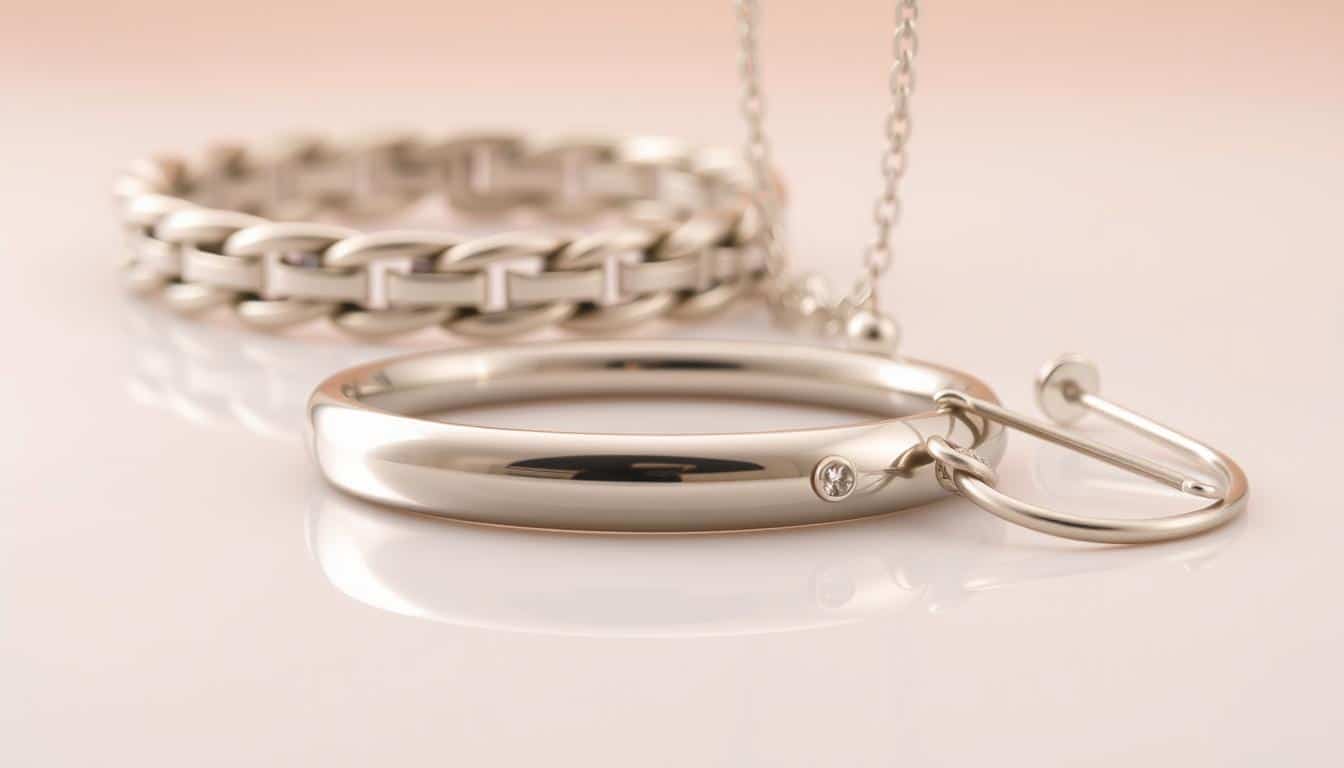
We have witnessed a significant surge in the popularity of stainless steel jewelry in recent years. This trend can be attributed to its durability and affordability. Made from an alloy of carbon and iron, with a minimum of 10.5% chromium content, stainless steel jewelry offers a unique blend of style and practicality.
As industry experts, we will explore the benefits and key considerations when choosing stainless steel jewelry, providing insights into its advantages and what makes it a desirable choice for many consumers.
Key Takeaways
- Stainless steel jewelry is durable and resistant to corrosion.
- It is an affordable option without compromising on quality.
- The chromium content enhances its strength and appearance.
- Stainless steel jewelry is versatile and suitable for various styles.
- It requires minimal maintenance, making it a practical choice.
What Is Stainless Steel Jewelry?
We explore the characteristics of stainless steel that have made it a favorite in jewelry making. Stainless steel jewelry is known for its durable and resistant properties, making it a popular choice among consumers.
Composition and Properties
Stainless steel is an alloy primarily composed of iron, carbon, and a minimum of 10.5% chromium. This composition gives stainless steel its unique properties, including durability and resistance to corrosion. The chromium content reacts with oxygen to form a thin layer of chromium oxide, protecting the metal from further corrosion.
The properties of stainless steel make it an ideal material for jewelry. It is hypoallergenic, making it suitable for sensitive skin, and it maintains its appearance over time with minimal maintenance.
| Property | Description | Benefit |
|---|---|---|
| Corrosion Resistance | Protected by a chromium oxide layer | Long-lasting |
| Durability | Strong and resistant to wear | Minimal maintenance |
| Hypoallergenic | Non-reactive with skin | Suitable for sensitive skin |
History of Stainless Steel in Jewelry Making
Stainless steel has been used in various industrial applications since its discovery. Its use in jewelry making is a more recent development, driven by its durability and modern aesthetic appeal. Over the years, stainless steel jewelry has evolved to include a wide range of designs, from minimalist to statement pieces.
The history of stainless steel in jewelry is closely tied to its industrial applications. As manufacturing techniques improved, stainless steel became more accessible for use in consumer goods, including jewelry.
Is Stainless Steel Jewelry Good?
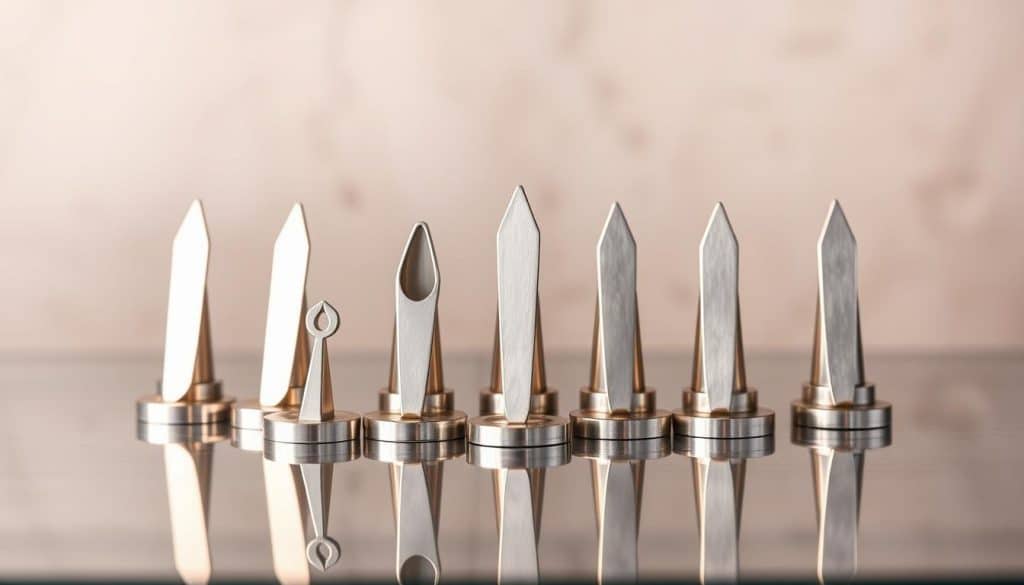
To determine if stainless steel jewelry is good, we need to examine its quality markers and benefits. Stainless steel jewelry has gained popularity due to its durability, resistance to tarnish, and hypoallergenic properties.
Quality Markers of Stainless Steel Jewelry
High-quality stainless steel jewelry is characterized by several key factors. These include:
- Durability: Resistance to wear and tear, ensuring the jewelry remains in good condition over time.
- Corrosion Resistance: The ability to withstand exposure to various environmental conditions without degrading.
- Hypoallergenic Properties: Suitable for individuals with sensitive skin, as it doesn’t cause allergic reactions.
- Finish and Design: The quality of the finish and the intricacy of the design contribute to its overall aesthetic appeal.
We evaluate these markers to ensure that the stainless steel jewelry meets our standards for quality and performance.
Common Misconceptions
Despite its many advantages, there are common misconceptions about stainless steel jewelry. Some of these include:
- The belief that stainless steel is not stylish: In reality, stainless steel jewelry comes in a wide range of styles and designs, catering to various tastes.
- The assumption that it is prone to rust: High-quality stainless steel is resistant to corrosion, making it a durable choice.
By understanding these misconceptions, we can better appreciate the true value of stainless steel jewelry.
| Quality Marker | Description | Benefit |
|---|---|---|
| Durability | Resistance to wear and tear | Long-lasting |
| Corrosion Resistance | Withstands environmental conditions | Maintains appearance |
| Hypoallergenic Properties | Suitable for sensitive skin | Safe for all wearers |
In conclusion, stainless steel jewelry offers numerous benefits, including durability, corrosion resistance, and hypoallergenic properties, making it a good choice for many consumers.
Types of Stainless Steel Used in Jewelry
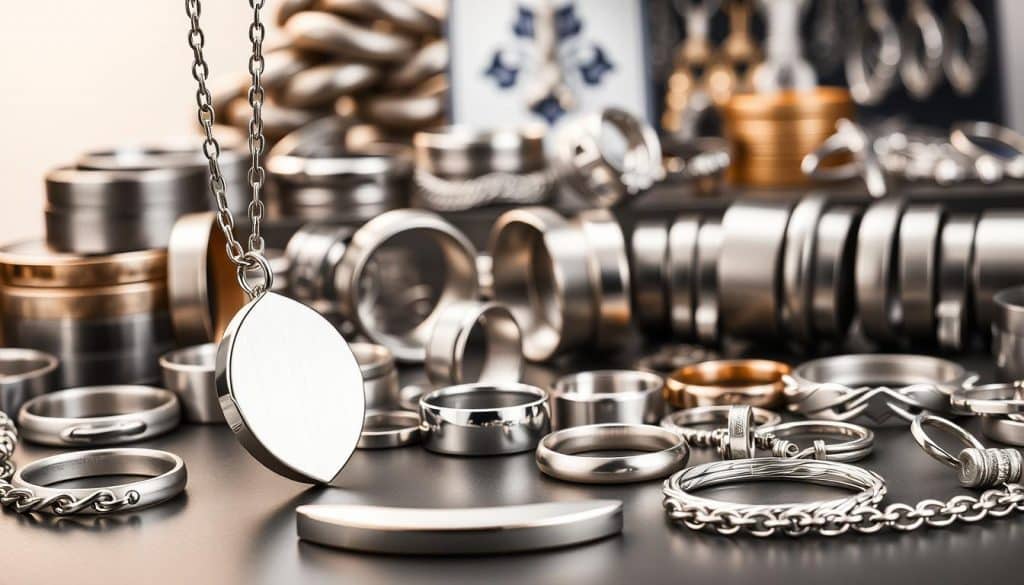
When it comes to stainless steel jewelry, the type of stainless steel used plays a crucial role in determining its quality and durability. Stainless steel jewelry is not made from just one type of stainless steel; rather, various grades are used, each offering distinct properties that cater to different needs and preferences.
316L Surgical Stainless Steel
One of the most popular and highly regarded types of stainless steel used in jewelry making is 316L Surgical Stainless Steel. This grade is known for its high corrosion resistance and biocompatibility, making it ideal for individuals with sensitive skin. The ‘L’ in 316L denotes low carbon content, which reduces the risk of corrosion and makes it suitable for surgical implants and, by extension, for jewelry that comes into contact with the skin.
Key benefits of 316L Surgical Stainless Steel include:
- High resistance to corrosion
- Biocompatibility, making it safe for wearers with sensitive skin
- Durability and strength
304 Stainless Steel
Another common grade used in stainless steel jewelry is 304 Stainless Steel. This type offers a good balance between durability and cost, making it a popular choice for a wide range of jewelry pieces. While not as corrosion-resistant as 316L, 304 Stainless Steel is still highly durable and suitable for everyday wear.
Characteristics of 304 Stainless Steel include:
- Good corrosion resistance
- High durability
- Cost-effective compared to 316L
Other Grades and Their Applications
Beyond 316L and 304, there are other grades of stainless steel used in jewelry, each with its own set of properties and applications. For instance, some jewelry pieces may use higher grades of stainless steel for added durability or specific aesthetic effects.
We often see the use of various stainless steel grades in different types of jewelry, such as:
- Rings and pendants that require high durability
- Earrings and bracelets where hypoallergenic properties are crucial
- Statement pieces that utilize different finishes and plating techniques
In conclusion, the type of stainless steel used in jewelry significantly impacts its durability, quality, and overall wearability. By understanding the different grades available, consumers can make informed decisions when selecting stainless steel jewelry that meets their needs.
7 Key Benefits of Stainless Steel Jewelry
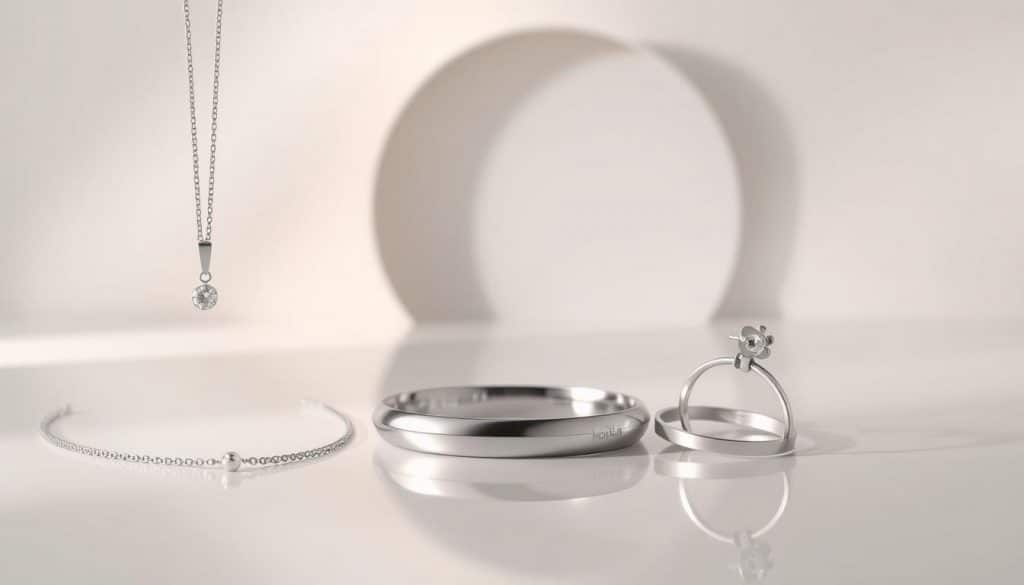
When it comes to jewelry, stainless steel offers a multitude of advantages that make it an attractive choice for many consumers. From its durability to its affordability, stainless steel jewelry provides a range of benefits that cater to different needs and preferences.
Durability and Longevity
One of the standout features of stainless steel jewelry is its exceptional durability and longevity. Unlike other materials that may wear out or break easily, stainless steel can withstand daily wear and tear, making it perfect for everyday jewelry.
Stainless steel jewelry is resistant to scratches and bending, ensuring that it remains in good condition for a long time. This durability translates to a longer lifespan for the jewelry piece, providing value for money.
Tarnish and Corrosion Resistance
Stainless steel jewelry is renowned for its resistance to tarnish and corrosion. This property is particularly beneficial for individuals who live in humid environments or are frequently exposed to water, as it ensures that the jewelry maintains its appearance over time.
The chromium content in stainless steel forms a protective layer that prevents corrosion, keeping the jewelry looking new and shiny.
Hypoallergenic Properties
For individuals with sensitive skin, stainless steel jewelry is an excellent choice due to its hypoallergenic properties. It is less likely to cause allergic reactions compared to jewelry made from other materials, making it suitable for people with skin sensitivities.
Affordability
Another significant advantage of stainless steel jewelry is its affordability. Compared to precious metals like gold or platinum, stainless steel jewelry is generally more budget-friendly, making it accessible to a wider range of consumers.
This affordability does not compromise on quality, as stainless steel jewelry is known for its durability and resistance to wear.
Overall, the benefits of stainless steel jewelry, including its durability, resistance to tarnish, hypoallergenic properties, and affordability, make it a popular and practical choice for many.
Potential Drawbacks of Stainless Steel Jewelry
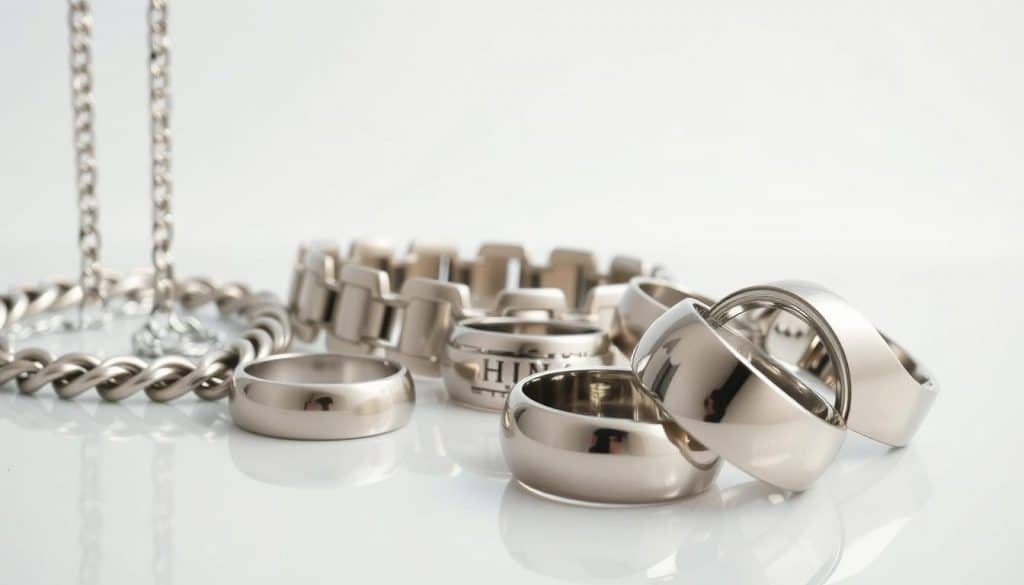
Stainless steel jewelry, known for its strength and resistance to corrosion, also has some limitations that consumers should be aware of. While it offers numerous benefits, there are certain aspects to consider when deciding if it’s the right choice for you.
Limited Malleability
One of the primary drawbacks of stainless steel jewelry is its limited malleability compared to precious metals like gold or silver. This means that stainless steel jewelry is less likely to be reshaped or resized, limiting its customization options. However, this also contributes to its durability, as it is less prone to bending or deformation.
Weight Considerations
Stainless steel jewelry can be heavier than jewelry made from other materials, which may be a consideration for those who prefer lightweight accessories. The weight is due to the density of stainless steel, which, while contributing to its durability, can make it less comfortable for extended wear in certain designs.
Resale Value
Another potential drawback is the resale value of stainless steel jewelry. Unlike gold or platinum, stainless steel does not retain its value over time in the same way, and it may not be as sought after in the resale market. This is an important consideration for those who view jewelry as an investment.
In conclusion, while stainless steel jewelry offers many advantages, including durability and affordability, it is essential to consider its limitations. By understanding the potential drawbacks, consumers can make informed decisions that best suit their needs and preferences.
Stainless Steel vs. Sterling Silver Jewelry
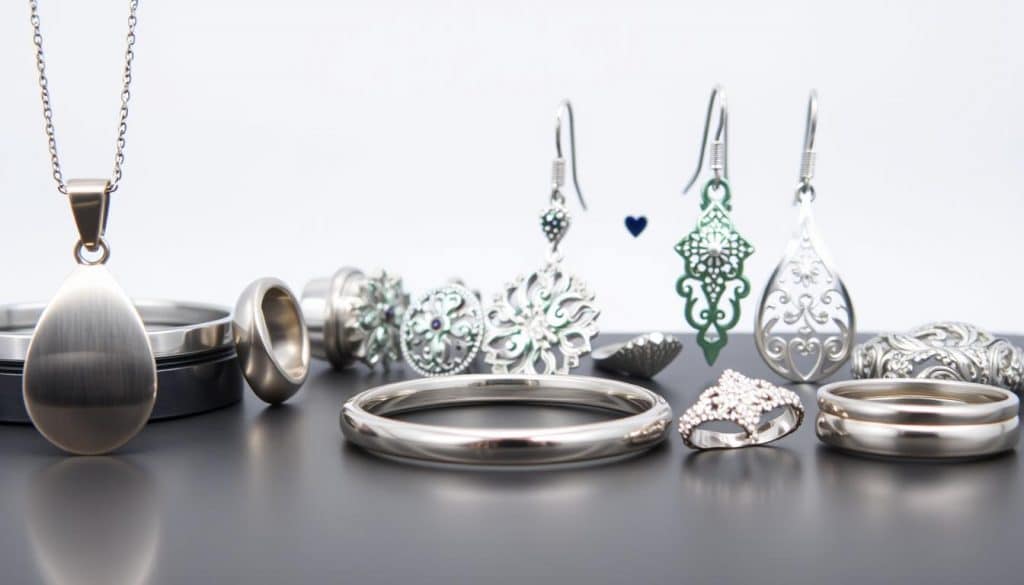
In the world of jewelry, stainless steel and sterling silver are often compared for their durability, aesthetic appeal, and cost. As industry experts, we understand the importance of making an informed decision when choosing between these two popular materials.
Durability Comparison
Stainless steel jewelry is renowned for its exceptional durability and resistance to corrosion. Unlike sterling silver, which can tarnish over time, stainless steel maintains its shine with minimal maintenance. Sterling silver, on the other hand, is a precious metal that, while durable, requires more upkeep to prevent tarnishing.
“Stainless steel jewelry is virtually maintenance-free, making it an excellent choice for everyday wear,” says a leading designer of stylish stainless steel jewelry. This characteristic is particularly appealing to those who prefer a hassle-free option.
Appearance Differences
The appearance of stainless steel and sterling silver jewelry differs significantly. Stainless steel has a modern, sleek look that appeals to those who prefer contemporary designs. Sterling silver, with its classic elegance, is often preferred by those who appreciate traditional jewelry.
- Stainless steel: Modern, sleek, and contemporary
- Sterling silver: Classic, elegant, and sophisticated
Price Point Analysis
When it comes to pricing, stainless steel jewelry is generally more affordable than sterling silver. The cost-effectiveness of stainless steel, combined with its durability, makes it an attractive option for budget-conscious consumers. Sterling silver, being a precious metal, is typically more expensive.
According to industry reports, the best stainless steel jewelry brands offer high-quality products at competitive prices, further enhancing the appeal of stainless steel jewelry.
| Material | Durability | Appearance | Price |
|---|---|---|---|
| Stainless Steel | High | Modern/Sleek | Affordable |
| Sterling Silver | Medium | Classic/Elegant | Moderate to High |
Stainless Steel vs. Gold Jewelry
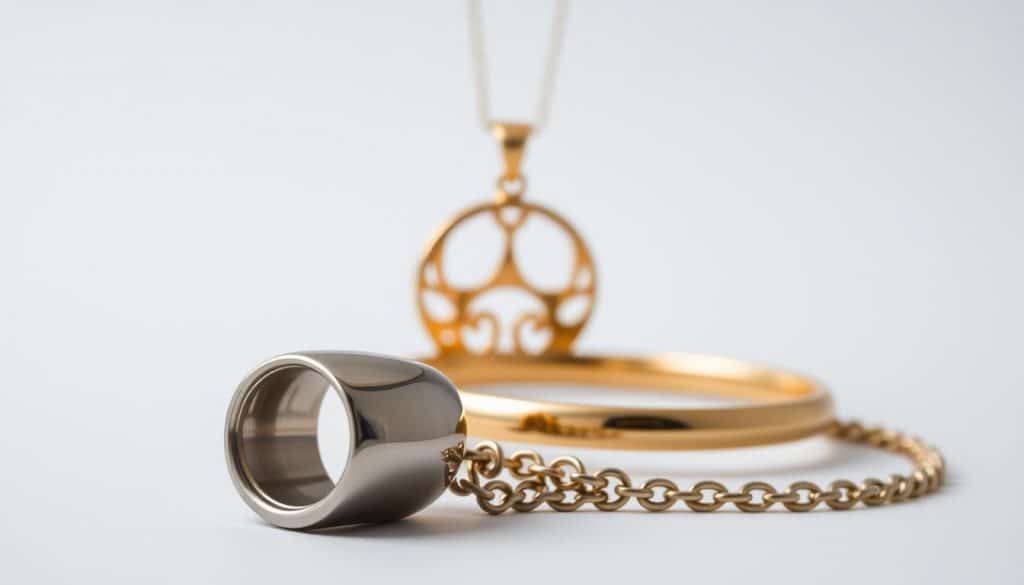
The debate between stainless steel and gold jewelry often centers around durability, style, and investment potential. Both materials have their unique advantages and cater to different consumer preferences.
Durability and Maintenance
Stainless steel jewelry is known for its exceptional durability and resistance to corrosion. Unlike gold, which is softer and more prone to scratches, stainless steel can withstand daily wear and tear with minimal maintenance. Gold jewelry, on the other hand, requires regular polishing to maintain its luster.
Key differences in durability:
- Stainless steel is more resistant to scratches and corrosion.
- Gold is softer and more susceptible to wear.
- Stainless steel requires less maintenance than gold.
Aesthetic Differences
The aesthetic appeal of stainless steel and gold jewelry differs significantly. Stainless steel has a modern, sleek appearance that is often associated with trendy stainless steel jewelry. Gold, with its warm, luxurious glow, is a traditional choice for those seeking a classic, timeless look.
Aesthetic comparison:
- Stainless steel offers a contemporary, industrial look.
- Gold provides a warm, luxurious appearance.
- Stainless steel is often preferred for its modern aesthetic.
Investment Value
Gold has long been considered a valuable investment due to its rarity and market demand. While stainless steel jewelry offers several advantages of stainless steel jewelry, such as affordability and durability, it does not hold the same investment value as gold.
| Material | Investment Potential | Resale Value |
|---|---|---|
| Gold | High | Good |
| Stainless Steel | Low | Poor |
In conclusion, the choice between stainless steel and gold jewelry depends on individual priorities regarding durability, aesthetics, and investment potential.
Stainless Steel vs. Titanium Jewelry
For those seeking high-quality jewelry, understanding the differences between stainless steel and titanium is crucial. Both materials are known for their durability and resistance to corrosion, but they have distinct characteristics that may make one more suitable than the other for certain individuals.
Weight and Strength Comparison
Stainless steel jewelry is often praised for its strength and durability. It is dense and has a substantial weight to it, which can be a desirable trait for those who prefer heavier jewelry. Titanium, on the other hand, is known for being incredibly lightweight while still maintaining a high level of strength. This makes titanium jewelry an excellent choice for those who prefer comfort without compromising on durability.
Key differences in weight and strength:
- Stainless steel is denser and heavier.
- Titanium is lighter and more comfortable to wear.
- Both materials offer high strength and durability.
Hypoallergenic Properties
Both stainless steel and titanium are considered hypoallergenic, making them suitable for individuals with sensitive skin. However, titanium is often regarded as the more hypoallergenic of the two due to its non-reactive nature. Stainless steel, particularly the 316L grade, is also highly resistant to causing allergic reactions.
Hypoallergenic considerations:
- Titanium is non-reactive and highly hypoallergenic.
- Stainless steel, especially 316L, is also hypoallergenic.
- Both are suitable for sensitive skin.
Price and Availability
The price of stainless steel and titanium jewelry can vary significantly. Stainless steel jewelry tends to be more affordable and widely available due to the commonality of the material and manufacturing processes. Titanium jewelry, while still considered affordable, can be more expensive due to the challenges associated with working with titanium.
Price and availability comparison:
- Stainless steel jewelry is generally more affordable.
- Titanium jewelry can be more expensive.
- Stainless steel is more widely available.
In conclusion, the choice between stainless steel and titanium jewelry depends on individual preferences regarding weight, strength, hypoallergenic properties, and budget. By understanding these differences, consumers can make informed decisions that best suit their needs.
Popular Types of Stainless Steel Jewelry
From everyday wear to special occasions, stainless steel jewelry offers a wide range of stylish options. This versatility is one of the key reasons for its growing popularity among jewelry enthusiasts.
Stainless Steel Rings
Stainless steel rings are a popular choice for their durability and modern look. They are available in various designs, from simple bands to intricate patterns.
Stainless Steel Bracelets and Watches
Stainless steel bracelets and watches are favored for their robustness and style. They can be worn on both casual and formal occasions.
Stainless Steel Necklaces and Pendants
Stainless steel necklaces and pendants offer a sleek, contemporary look. They are often paired with gemstones or other decorative elements to enhance their appeal.
Stainless Steel Earrings
Stainless steel earrings are known for their hypoallergenic properties and stylish designs. They range from minimalist studs to elaborate drop earrings.
| Type | Characteristics | Occasion |
|---|---|---|
| Stainless Steel Rings | Durable, Modern Look | Everyday, Formal |
| Stainless Steel Bracelets and Watches | Robust, Stylish | Casual, Formal |
| Stainless Steel Necklaces and Pendants | Sleek, Contemporary | Formal, Special Occasions |
| Stainless Steel Earrings | Hypoallergenic, Stylish | Everyday, Formal |
Trendy Stainless Steel Jewelry Designs
Trendy stainless steel jewelry designs are revolutionizing the way we accessorize, offering a blend of durability and style. Stainless steel jewelry is available in a range of designs, from minimalist styles to statement pieces and mixed metal designs.
Minimalist Stainless Steel Jewelry
Minimalist stainless steel jewelry is perfect for those who prefer understated elegance. These pieces are characterized by clean lines, simple shapes, and a lack of clutter. Minimalist designs are versatile and can be easily paired with other jewelry pieces or worn alone for a subtle look.
Statement Pieces
For those who like to make a bold statement, stainless steel jewelry offers a range of eye-catching designs. Statement pieces can feature intricate details, geometric patterns, or bold textures, making them perfect for special occasions or everyday wear for those who like to stand out.
Mixed Metal Designs
Mixed metal designs combine stainless steel with other metals, creating unique and stylish pieces. These designs allow for a mix of different textures and colors, adding depth and interest to the jewelry. Mixed metal stainless steel jewelry is ideal for those who like to experiment with different looks and styles.
| Design Style | Characteristics | Ideal For |
|---|---|---|
| Minimalist | Clean lines, simple shapes | Understated elegance, everyday wear |
| Statement Pieces | Intricate details, bold textures | Special occasions, making a statement |
| Mixed Metal | Combination of metals, textures, and colors | Experimenting with different styles, unique looks |
We see a growing trend towards personalized and customizable stainless steel jewelry, allowing individuals to express their unique style and preferences. Whether you’re looking for a simple, elegant piece or a bold statement, stainless steel jewelry offers a wide range of options to suit every taste and occasion.
Customization Options for Stainless Steel Jewelry
The versatility of stainless steel jewelry allows for various personalization techniques, including engraving and plating. This flexibility makes stainless steel a popular choice for those seeking unique and customized pieces.
Engraving Possibilities
Engraving is a popular method for customizing stainless steel jewelry. It allows for the addition of personal messages, names, or special dates, making the piece more meaningful. We use advanced engraving techniques to ensure precision and quality.
Types of Engraving:
- Laser engraving for precise and intricate designs
- Hand engraving for a more personal touch
Plating and Coloring Techniques
Plating and coloring techniques can significantly enhance the appearance of stainless steel jewelry. Various plating options, such as gold, silver, and rose gold, are available, offering a range of aesthetic choices.
Plating Options:
| Plating Type | Description | Durability |
|---|---|---|
| Gold Plating | Gives a luxurious gold finish | High |
| Silver Plating | Provides a sleek, modern look | Medium |
| Rose Gold Plating | Offers a warm, romantic appearance | High |
Gemstone Settings
Gemstone settings are another way to customize stainless steel jewelry, adding color and elegance. We work with a variety of gemstones, ensuring they are securely set to enhance the overall design.
By combining these customization options, we can create truly unique stainless steel jewelry pieces that reflect individual styles and preferences. Whether you’re looking for a special gift or a personal treat, customized stainless steel jewelry is an excellent choice.
How to Care for Stainless Steel Jewelry
Maintaining the quality of your stainless steel jewelry requires some simple yet effective care techniques. We understand that durable stainless steel jewelry is a valuable investment, and proper care ensures it remains in excellent condition for years to come.
To keep your stainless steel jewelry looking its best, it’s essential to adopt a regular cleaning routine. We recommend using mild soap and warm water to clean your jewelry. A soft-bristled toothbrush can be used to gently scrub intricate designs or engravings.
Cleaning Methods
There are several effective methods for cleaning stainless steel jewelry. One approach is to use a mixture of mild soap and warm water. Soak the jewelry for a few minutes, then gently scrub it with a soft-bristled toothbrush. Rinse thoroughly with clean water and dry with a soft cloth to prevent water spots.
For more stubborn dirt or grime, you can use a specialized jewelry cleaning solution. Ensure the solution is compatible with stainless steel to avoid any damage. Avoid using harsh chemicals, abrasive materials, or ultrasonic cleaners, as they can damage the jewelry or harm its finish.
Storage Tips
Proper storage is crucial to maintaining the quality of your stainless steel jewelry. Store each piece separately to prevent scratching or tangling. You can use individual pouches, jewelry boxes with separate compartments, or soft cloth wraps to protect your jewelry.
When not in use, keep your stainless steel jewelry in a cool, dry place. Avoid storing jewelry in humid environments or near direct sunlight, as this can cause tarnishing or discoloration over time.
Avoiding Damage
While stainless steel jewelry is known for its durability, it’s not indestructible. Avoid exposing your jewelry to harsh chemicals, such as chlorine or bleach, as they can cause damage or discoloration. Remove your jewelry before engaging in activities that could cause physical stress, such as heavy lifting or sports.
By following these simple care tips, you can enjoy the benefits of stainless steel jewelry for a long time. Regular cleaning, proper storage, and avoiding potential damage will keep your jewelry looking its best.
Best Stainless Steel Jewelry Brands
From luxury to affordable, the best stainless steel jewelry brands offer something for everyone. The market is diverse, with various brands catering to different tastes and preferences.
Luxury Stainless Steel Jewelry Brands
Luxury brands bring a touch of elegance and sophistication to stainless steel jewelry. They are known for their high-quality materials and exquisite craftsmanship.
- Tiffany & Co.: Known for their iconic designs, Tiffany & Co. offers a range of stainless steel jewelry pieces that exude luxury.
- Cartier: This prestigious brand combines stainless steel with other precious materials to create truly unique pieces.
Affordable Quality Brands
Not everyone wants to splurge on luxury jewelry, and that’s where affordable quality brands come in. They offer stylish stainless steel jewelry without the hefty price tag.
| Brand | Notable Features | Price Range |
|---|---|---|
| Daniel Wellington | Minimalist designs, watch collections | $100-$500 |
| Skagen | Scandinavian design, simple elegance | $100-$300 |
Specialized Designers
Some brands specialize in specific types of stainless steel jewelry, offering unique designs that cater to niche markets.
- King Ice: Known for their bold, statement pieces, King Ice is a favorite among those who like to make a fashion statement.
- Rockport: This brand offers comfortable, stylish jewelry that is perfect for everyday wear.
These brands, among others, have made significant contributions to the world of stainless steel jewelry, offering a range of styles and price points that cater to diverse consumer preferences.
Sustainability of Stainless Steel Jewelry
As consumers become more environmentally conscious, the sustainability of stainless steel jewelry has become a significant factor in its appeal. We will explore the various aspects that contribute to its eco-friendly reputation.
Environmental Impact
The production of stainless steel involves mining and processing raw materials, which can have environmental implications. However, stainless steel is primarily made from recycled materials, significantly reducing its carbon footprint.
According to the International Stainless Steel Forum, the production of stainless steel from recycled materials reduces energy consumption by up to 70% compared to production from raw materials.
Recyclability
One of the most significant advantages of stainless steel jewelry is its recyclability. Stainless steel is 100% recyclable, and the recycling process does not degrade the material’s quality.
Key Benefits of Recyclability:
- Conservation of natural resources
- Reduction in landfill waste
- Energy savings compared to producing new stainless steel
Ethical Considerations
The sourcing of raw materials for stainless steel production can raise ethical concerns. We must consider the labor practices and environmental policies of suppliers.
“Responsible sourcing is crucial in ensuring that the production of stainless steel jewelry does not contribute to environmental degradation or human rights violations.” –
| Production Method | Energy Consumption | Water Usage | CO2 Emissions |
|---|---|---|---|
| Raw Materials | 100% | 100% | 100% |
| Recycled Materials | 30% | 40% | 20% |
In conclusion, stainless steel jewelry offers several sustainability benefits, including a reduced environmental impact due to its recyclability and the potential for using recycled materials in its production.
Conclusion: Is Stainless Steel Jewelry Worth It?
Stainless steel jewelry has proven to be a valuable choice for those seeking durability, affordability, and style versatility. Throughout this article, we have explored the numerous benefits of stainless steel jewelry, including its hypoallergenic properties, resistance to tarnish and corrosion, and wide range of design options.
We have seen that stainless steel jewelry is a good choice for individuals with sensitive skin, as it is less likely to cause allergic reactions. The benefits of stainless steel jewelry also extend to its affordability and durability, making it an attractive option for everyday wear.
When considering whether stainless steel jewelry is worth it, we conclude that its advantages make it a worthwhile investment. With proper care, stainless steel jewelry can maintain its appearance and functionality over time, providing long-term value to the wearer.
As industry leaders, we recommend exploring the various types and designs of stainless steel jewelry to find the perfect piece that suits your style and preferences. By choosing stainless steel jewelry, you are opting for a durable, stylish, and affordable accessory that can be enjoyed for years to come.
FAQ
Is stainless steel jewelry durable?
Yes, stainless steel jewelry is known for its durability and resistance to wear and tear, making it a great choice for everyday wear.
What are the benefits of choosing stainless steel jewelry?
Stainless steel jewelry offers several benefits, including its durability, resistance to tarnish, hypoallergenic properties, and affordability, making it a popular choice among jewelry enthusiasts.
How do I care for my stainless steel jewelry?
To care for your stainless steel jewelry, simply clean it with mild soap and water, dry it thoroughly, and store it in a cool, dry place to prevent damage.
Can stainless steel jewelry be customized?
Yes, stainless steel jewelry can be customized with various options such as engraving, plating, and gemstone settings, allowing you to create unique and personalized pieces.
Is stainless steel jewelry hypoallergenic?
Yes, stainless steel jewelry is generally hypoallergenic, making it a great choice for individuals with sensitive skin or allergies to certain metals.
How does stainless steel jewelry compare to other materials like silver or gold?
Stainless steel jewelry offers a more affordable and durable alternative to silver or gold, with its own unique aesthetic and benefits, making it a great choice for those looking for a stylish and practical option.
What are the different types of stainless steel used in jewelry?
The most common types of stainless steel used in jewelry are 316L and 304 grades, each with its own properties and applications, allowing for a range of styles and designs.
Is stainless steel jewelry sustainable?
Yes, stainless steel jewelry is considered a sustainable option due to its recyclability, durability, and minimal environmental impact, making it a great choice for eco-conscious consumers.
Can stainless steel jewelry be repaired or resized?
While stainless steel jewelry can be challenging to repair or resize due to its hardness, some jewelers specialize in working with stainless steel, offering repair and resizing services.
What are some popular designs and styles in stainless steel jewelry?
Stainless steel jewelry comes in a wide range of styles, from minimalist designs to statement pieces, and can be paired with various materials, such as gemstones or other metals, to create unique and trendy looks.
share this recipe:
Still hungry? Here’s more

Top 5 Gold Filled Jewelry Manufacturers in China 2026
What Is Gold Filled Jewelry? Gold filled jewelry meaning When I say gold filled jewelry,

How to Clean Gold Plated Jewelry Safely at Home
If your gold-plated jewelry has started to look dull, dark, or even a bit green,

PVD Jewelry Guide Durable Hypoallergenic Tarnish Resistant
You’re tired of jewelry that fades, tarnishes, or turns your skin green after a few
Ready to Design Your Own Jewelry?
Have an idea in mind or need help shaping it? From sketches to finished pieces, our custom jewelry team will work with you step-by-step to bring your vision to life.
